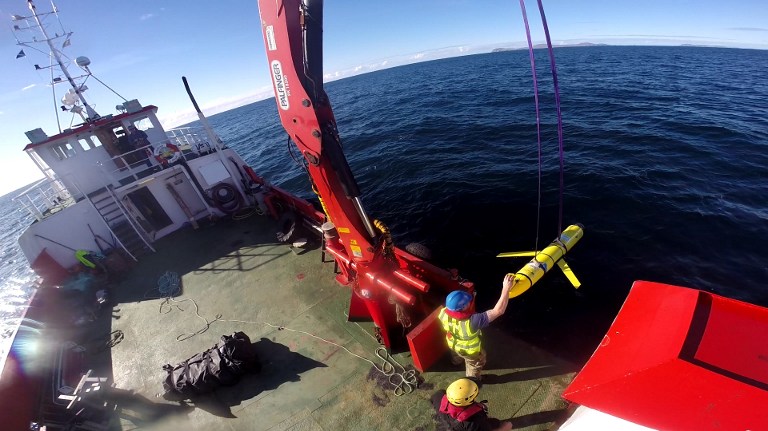
A similar unmanned underwater vehicle was seized by the Chinese Navy in international waters off the coast of the Philippines on December 15, 2016. The underwater probe was taken around 50 nautical miles (90 kilometers) northwest off Subic Bay in the Philippines on December 15 in a non-violent incident, Pentagon spokesman Navy Captain Jeff Davis said. The event unfolded as the civilian-crewed USNS Bowditch was retrieving a pair of “naval gliders” that routinely collect information on water temperatures, salinity and sea clarity.
by Thomas Watkins
Agence France-Presse
WASHINGTON, United States (AFP) – China “unlawfully” seized an unmanned US naval probe in international waters in the South China Sea, the Pentagon said Friday, a move sure to heighten tensions around Beijing’s military presence in the disputed area.
The underwater probe was taken around 50 nautical miles (90 kilometers) northwest off Subic Bay in the Philippines on Thursday afternoon in a non-violent incident, Pentagon spokesman Navy Captain Jeff Davis said.
The event unfolded as the civilian-crewed USNS Bowditch was retrieving a pair of “naval gliders” that routinely collect information on water temperatures, salinity and sea clarity.
A Chinese Dalang-III class submarine rescue ship then stopped within 500 yards (meters) of the Bowditch and snatched one of the probes. The Americans safely hoisted the other one back onto their ship.
Davis said he could not recall another time when something like this has happened, and the Pentagon issued a statement calling on Beijing to “immediately” return the probe that it had “unlawfully seized.”
The US personnel “were asking over bridge-to-bridge radio to please leave it there,” Davis said.
Other than a brief acknowledgment that it had received the message, the Chinese ship did not respond.
“The only thing they said after they were sailing off into the distance was: ‘We are returning to normal operations,'” Davis said.
Washington has issued a formal request through diplomatic channels to ask for the probe back.
“It is ours. It is clearly marked as ours. We would like it back, and we would like this not to happen again,” Davis said.
Pentagon press secretary Peter Cook said China had acted unlawfully.
“The UUV (unmanned underwater vehicle) is a sovereign immune vessel of the United States. We call upon China to return our UUV immediately, and to comply with all of its obligations under international law,” Cook said in a statement.
Heightened tensions
Davis said the seized vessel is off-the-shelf technology that is commercially available for about $150,000. Data it gathers are unclassified and can be used to help submarines navigate and determine sonar ranges in murky waters.
The incident comes amid rising tensions in the South China Sea, where China has moved to fortify its claims to the region by building out tiny reefs and islets into much larger artificial islands.
The Philippines, Brunei, Malaysia and Vietnam have competing claims in the South China sea, which is laced with the world’s most heavily traveled international trade routes.
New satellite imagery made public Wednesday by a US-based think tank showed China apparently has installed what appeared to be large anti-aircraft guns and close-in weapons systems on seven islets in the Spratly chain.
While the United States takes no position on sovereignty claims in the South China Sea, it has repeatedly stressed all maritime claims must comply with international law.
The US military has conducted several “freedom of navigation” operations in which ships and planes have passed close to the sites Beijing claims.
Such missions have drawn howls of fury from China, which accuses Washington of provocation and increasing the risk of a military mishap.
The USNS Bowditch is a research and survey vessel, and does not look like a warship.
Adding to the tension, Beijing is facing a new US president in Donald Trump, who has questioned longstanding US policy on Taiwan, called Beijing a currency manipulator and threatened Chinese imports with punitive tariffs.
The Chinese ship’s hull number was ASR-510, the Pentagon said.







